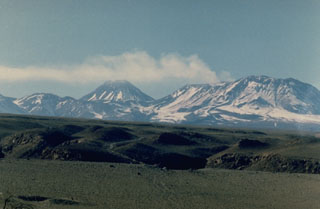Report on Lascar (Chile) — June 1995
Bulletin of the Global Volcanism Network, vol. 20, no. 6 (June 1995)
Managing Editor: Richard Wunderman.
Lascar (Chile) Small eruptions on 10 May and 20 July
Please cite this report as:
Global Volcanism Program, 1995. Report on Lascar (Chile) (Wunderman, R., ed.). Bulletin of the Global Volcanism Network, 20:6. Smithsonian Institution. https://doi.org/10.5479/si.GVP.BGVN199506-355100
Lascar
Chile
23.37°S, 67.73°W; summit elev. 5592 m
All times are local (unless otherwise noted)
At 1450 on 20 July 1995, an aircraft pilot passing 130 km W of Lascar reported eruptive activity from the volcano. The pilot saw a dispersed, SE-directed plume located in the 6-9 km altitude range. The plume's density was moderate and its color, light gray. At 1621, in conditions of clear visibility, a second pilot (Lloyd Boliviano) noticed the plume at the same distance from the volcano. The plume originated from Lascar's crater and at that time only rose about 700 m before dispersing SE where it remained visible for more than an estimated 90 km. At the crater the plume looked white to light gray and moderately dense. This second observation confirmed a sustained eruption.
Near the volcano, observers suggested that an eruption started between 1245 and 1315, accompanied by underground booming noises. Although in conflict with the pilot reports, officers located 67 km NW of Lascar (San Pedro de Atacama) stated that at 1445 the eruption ceased completely, maintaining only a small, diffuse column of gases.
Secondary information from San Pedro de Atacama (municipal administrator Juan Carlos Pereira) suggested that at 1320 there were underground booming sounds near the volcano and at 1330 a gray column rose to 2.5 km above the volcano. This column traveled towards the E and rained ash 6 km from the vent. The same behavior was repeated three times with less intensity.
In Toconao, 34 km NW of Lascar, Sara Moncada confirmed the eruption in the 1300-1400 time interval, although she heard no sounds at that locality. The next day, 21 July, the volcano returned to its more normal state with white fumarolic degassing.
According to a news broadcast, a previous episode occurred on 10 May consisted of three explosions, also accompanied by underground explosions. Columns then were <800-m high. The previous Lascar report (BGVN 20:03) discussed collapse of the crater's S rim and plumes that rose several kilometers and rained ash onto Toconao.
Geological Summary. Láscar is the most active volcano of the northern Chilean Andes. The andesitic-to-dacitic stratovolcano contains six overlapping summit craters. Prominent lava flows descend its NW flanks. An older, higher stratovolcano 5 km E, Volcán Aguas Calientes, displays a well-developed summit crater and a probable Holocene lava flow near its summit (de Silva and Francis, 1991). Láscar consists of two major edifices; activity began at the eastern volcano and then shifted to the western cone. The largest eruption took place about 26,500 years ago, and following the eruption of the Tumbres scoria flow about 9000 years ago, activity shifted back to the eastern edifice, where three overlapping craters were formed. Frequent small-to-moderate explosive eruptions have been recorded since the mid-19th century, along with periodic larger eruptions that produced ashfall hundreds of kilometers away. The largest historical eruption took place in 1993, producing pyroclastic flows to 8.5 km NW of the summit and ashfall in Buenos Aires.
Information Contacts: Jose Antonio Naranjo, Programa Riesgo Volcanico, Servicio Nacional de Geologia y Mineria, Avda. Santa Maria 0104, Casilla 1347, Santiago, Chile.

